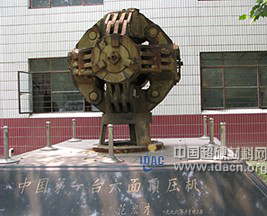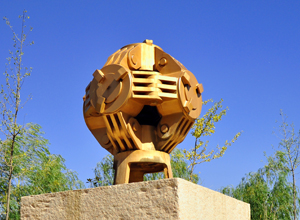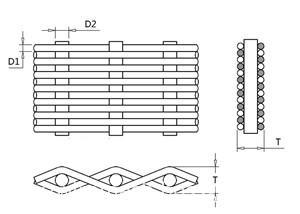China's first hinged six-sided diamond synthesis press documentary
Stainless Steel Plain Dutch Weave Mesh, also known as wire mesh, it is
made of high quality stainless steel wire. Similar to plain weave, it is weaved
line by line. But for this kind of Stainless Steel Wire Cloth, the difference
is the diameter of the weft is more thicker than the diameter of the warp. The
weft wire is close together and then form a conical or wedge shaped hole. There
is a big contrast between warp and weft wire diameter and density, so the net
thickness and filtration precision and service life is significantly improved
than common steel mesh. the filtering precision is running cannot be achieved
for plain weave and Twill Weave Mesh screen.
Weaving: There are two kinds of weaving technology of
Dutch woven Stainless Steel Mesh . One is plain Dutch knitting and the other is
twill Dutch knitting. The weaving technology of Dutch woven stainless steel mesh
combines Dutch knitting and twill weaving techniques. The coarser thread
interleaved the finer threads, weaving each thread through the weft. The weft
wire is closely aligned to form a cone or wedge open hole.
Features: Dutch
woven stainless steel mesh features 4 points:
1."Zero"
mesh, the warp wire diameter than the weft to the larger diameter.
2. Each weft is very
tight
3. High precision,
high liquidity
4. Filter more solid
particles than square or rectangular mesh holes
Material: 201,302,304 (L), 310,316 (L), etc
Application: The
Dutch weave Stainless Steel Wire Mesh is one of the best filter medium in
hydraulic system, especially the spatial filtering critical applications, as
well as the fuel and combustion chamber filter, sediment filter, vacuum filter,
etc.
The warp wire (D1) : all longitudinal
braided lines.
The weft wire (D2) : all horizontal weaving
lines.
Aperture : the distance between two
meridians or two weft.
Mesh number:number of mesh holes per inch.
Thickness (T) : thickness of wire mesh.
Specifiaction list:
Plain
Dutch Woven Stainless Steel Mesh
SPEC
NUMBER OF
HOLES PER INCH
WIRE DIAMETER
APERTURE(micron)
40
10mesh x 64mesh
0.55x0.42
260
50
12mesh x 75mesh
0.45x0.35
220
80
24mesh x 110mesh
0.35x0.25
160
100
25mesh x 140mesh
0.28x0.20
100
120
30mesh x 150mesh
0.25x0.18
80
140
35mesh x 180mesh
0.20x0.16
70
160
40mesh x 200mesh
0.18x0.13
60
180
45mesh x 220mesh
0.16x0.12
56
200
50mesh x 250mesh
0.15x0.11
50
240
60mesh x 300mesh
0.14x0.09
45
260
65mesh x 320mesh
0.13x0.08
36
280
70mesh x 400mesh
0.125x0.07
34
300
80mesh x 700mesh
0.11x0.039
32
Stainless Steel Plain Dutch Weave Mesh Stainless Steel Plain Dutch Weave Mesh,Plain Dutch Weave Mesh,Fine Metal Mesh,Stainless Steel Woven Wire Mesh Anping Xinzheng Metal Wire Mesh Co., Ltd , https://www.sievingmesh.com
In August 1965 , under the close cooperation of Sanma Institute of Jinan Casting and Forging, the first 6×6MN DS-023 hinged six-sided anvil ultra-high pressure and high-temperature diamond synthesis device was produced in China. Sanguang Institute Wang Guangzu, Yu Zhengmin, Yu Zhichao Li Jinbao, Shao Dehou, Yan Juwu, and Kong Lingchun conducted synthetic diamond tests in Jinan forging and forging. November 5, 1965, at 6 × 6MN DS-023 type six-sided hinged first synthesis of a diamond, which is an important sign of success hinged six of the top diamond synthesis device trial with Chinese characteristics. After six months of testing repeatability synthesis of diamond synthesis process stabilized, on June 7, 1966, that six of the top synthesizing apparatus departure from Jinan, Zhengzhou three mill to reach the 10th.
July 3, 1966, voted man-made diamond synthesis intermediate test work. In the year of production of 10,000 carats of diamonds, in October 1966, the Ministry of Machinery Industry approved the construction of China's first synthetic diamond plant, the sixth grinding wheel factory, in the suburb of Guiyang, Guizhou Province, China. The complete process design and technical information provided by Sanmao was provided. And responsible for personnel training. This is the beginning of the industrial production of synthetic diamonds in China. The hinged six-sided diamond synthesis press has laid the foundation for the industrial production of synthetic diamond in China.
When Zhengzhou Sanmao built the national superhard materials and products engineering technology research center in 1996, the press was saved as an important cultural relic of China's superhard material industry in No. 121 Huashan Road. The Ministry of Machinery Industry is super hard on the country. At the acceptance of the Materials and Products Engineering Technology Research Center, Mr. Fan Hongcai, then the chief engineer of the Ministry of Machinery Industry, wrote the “ China's first six-sided top press †for the press .
The press was commissioned in 1965. It was retired in 1995 and put into operation for 30 years. It was synthesized about 1.5 million times and was named as a meritorious press.

When Zhengzhou Sanmao moved to No. 121 Wutong Street in Zhengzhou High-tech Industrial Development Zone in 2010, the press was moved together. It is displayed in the courtyard of Zhengzhou Abrasives Grinding Research Institute (No. 121 Wutong Street). 

